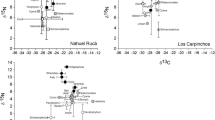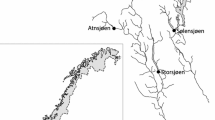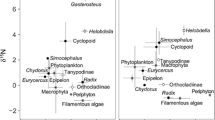Abstract
Fishes consume prey from across both benthic and pelagic habitats, thereby stabilizing the food webs of freshwater lakes. How fish exploit vertical and horizontal heterogeneity within the benthic environment, however, remains unclear. We characterized spatial variation in the C and N stable isotopes of a dominant benthic grazer (snails) along a water depth gradient in an oligotrophic, western Alaska lake to assess the effects of water depth on isotope characteristics in the benthic food web. Importantly, carbon stable isotopes in snails become substantially more depleted in 13C with increasing water depth. We compared this distribution of snail isotope values to those found in Arctic char (Salvelinus alpinus) diets to estimate the vertical location of char foraging on benthic resources. We found that Arctic char tended to prey on snails at greater than 10 m depth; however, individual fish specialized at a narrower range of water depths spanning from 5 to > 20 m. We used an isotope mixing model to assess the validity of using only shallow-water benthic invertebrates to represent all benthic resources in food web reconstructions and found that mixing models that only used shallow benthic prey underestimated the importance of benthic resources by about 50%. These results can help refine our understanding of how benthic prey contribute to the stability of aquatic food webs and highlight the need to account for spatial variation in the isotope composition of benthic resources in models of lake food webs.




Similar content being viewed by others
References
Armstrong JB, Bond MH (2013) Phenotype flexibility in wild fish: Dolly Varden regulate assimilative capacity to capitalize on annual pulsed subsidies. J Anim Ecol 82:966–975
Bentley KT, Schindler DE, Jonathan AB, Zhang R, Ruff CP, Lisi PJ (2012) Foraging and growth responses of stream-dwelling fishes to inter-annual variation in a pulsed resource subsidy. Ecosphere 3(12):113
Bootsma HA, Hecky ER, Hesslein HR, Turner FG (1996) Food partitioning among lake Malawi nearshore fishes as revealed by stable isotope analyses. Ecology 77:1286–1290
Cabana G, Rasmussen BJ (1996) Comparison of aquatic food chains using nitrogen isotopes. Proc Natl Acad Sci 93:10844–10847
Carter JL, Schindler DE (2012) Responses of zooplankton populations to four decades of climate warming in lakes of southwestern Alaska. Ecosystems 15:1010–1026
Chandra S, Vander Zanden JM, Heyvaert AC, Richards BC, Allen BC, Charles GR (2005) The effects of cultural eutrophication on the coupling between pelagic primary producers and benthic consumers. Limnol Oceanog 50:1368–1376
Christensen RD, Moore CB (2009) Using stable isotopes and a multiple-source mixing model to evaluate fish dietary niches in a mesotrophic lake. Lake Reservoir Manage 25:167–175
Covich AP, Palmer MA, Crowl TA (1999) The role of benthic invertebrate species in freshwater ecosystems: zoobenthic species influence energy flows and nutrient cycling. Bioscience 49:119–127
Cummings BM, Schindler DE (2013) Depth variation in isotopic composition of benthic resources and assessment of sculpin feeding patterns in an oligotrophic Alaskan lake. Aquat Ecol 47:403–414
DeNiro MJ, Epstein S (1978) Influence of diet on the distribution of carbon isotopes in animals. Geochim Cosmochim Acta 42:495–506
Denton KP, Rich HB Jr, Moore JW, Quinn TP (2010) The utilization of a Pacific salmon Oncorhynchus nerka subsidy by three populations of charr Salvelinus spp. J Fish Biol 77:1006–1023
Doi H, Yurlova IN, Kikuchi E, Shinako S, Yadrenkina NE, Vodyanitskaya NS, Zuykova IE (2010) Stable isotopes indicate individual level trophic diversity in the freshwater gastropod Lymnea stagnalis. J Molluscan Stud 76:384–388
Erikson JW, Buck GB, McKinley TR, Zhang X, Hamazaki T, Saviour AB. 2018. Review of salmon escapement goals in Bristol Bay, Alaska 2018. Alaska Department of Fish and Game, Fishery Manuscript No. 18–06. Anchorage
France LR (1995) Differentiation between littoral and pelagic food webs in lakes using stable carbon isotopes. Limnol Oceanogr 40:1310–1313
Hayden B, Harrod C, Kahilainen KK (2014) Dual fuels: intra-annual variation in the relative importance of benthic and pelagic resources to maintenance, growth and reproduction in a generalist salmonid fish. J Anim Ecol 83:1501–1512
Hecky ER, Hesslein HR (1995) Contributions of benthic algae to lake food webs as revealed by stable isotope analysis. Journal of North American Benthological Sciences 14:631–653
Jeppesen E, Jensen PJ, Søndergaard M, Lauridsen T (1997) Top-down control in freshwater lakes: the role of nutrient state, submerged macrophytes and water depth. Hydrobiologia 342(343):151–164
Jonsson B, Jonsson N (2001) Polymorphism and speciation in Arctic charr. J Fish Biol 58:605–638
Mangel M, Hilborn R (1997) The ecological detective: confronting models with data. Princeton University Press
Marklund MHK, Svanbeack R, Eklov P (2019) Habitat coupling mediates trophic cascades in an aquatic community. Ecosphere. https://doi.org/10.1002/ecs2.2863
McBride DN (1980) Homing of Arctic char, Salvelinus alpinus (Linnaeus) to feeding and spawning sited in the Wood River lake system. Alaska Department of Fish and Game. Informational Leaflet No. 184. Anchorage
McCann KS, Rasmussen JB, Umbanhowar J (2005) The dynamics of spatially coupled food webs. Ecol Lett 8:513–523
McGlauflin MT, Schindler DE, Seeb LW, Smith CT, Habicht C, Seeb JE (2011) Spawning habitat and geography influence population structure and juvenile migration timing of sockeye salmon in the Wood River Lakes, Alaska. Trans Am Fish Soc 140:763–782
Moore JW, Schindler DE (2008) Biotic disturbance and benthic community dynamics in salmon-bearing streams. J Anim Ecol 77:275–284
Moore JW, Semmens BX (2008) Incorporating uncertainty and prior information into stable isotope mixing models. Ecol Lett 11:470–480
Ostrom NE, Long DT, Bell EM, Beals T (1998) The origin and cycling of particulate and sedimentary organic matter and nitrate in Lake Superior. Chem Geol 152:13–28
Peterson JB, Fry B (1987) Stable isotopes in ecosystem studies. Annu Rev Ecol Syst 18:293–320
Post DM (2002) Using stable isotopes to estimate trophic position: models, methods, and assumptions. Ecology 83:703–718
Reynolds CS (2008) A changing paradigm of pelagic food webs. Int Rev Hydobiol 93(4–5):517–531
Ruggerone GT, Rogers DE (1983) Arctic char predation on sockeye salmon smolts at Little Togiak River Alaska. Fish Bull 82(2):401–410
Scheuerell MD, Schindler DE (2003) Diel vertical migration by juvenile sockeye salmon: empirical evidence for the antipredation window. Ecology 84(7):1713–1720
Schindler DE, Scheurell MD (2002) Habitat coupling in lake ecosystems. Oikos 98(2):177–189
Schindler DE, Hodgson JR, Kitchell JF (1997) Density-dependent changes in individual foraging specialization of largemouth bass. Oecologia 110:592–600
Sierszen EM, McDonald EM, Jensen AD (2003) Benthos as the basis for arctic lake food webs. Aquat Ecol 37:437–445
Sierszen EM, Peterson SG, Scharold VJ (2006) Depth-specific patterns in benthic–planktonic food web relationships in Lake Superior. Can J Aquat Fish Sci 63:1496–1503
Sierszen EM, Hrabik RT, Stockwell DG, Cotter MA, Hoffman CJ, Yule LD (2014) Depth gradients in food-web processes linking habitats in large lakes: lake superior as an exemplar ecosystem. Freshw Biol 59:2122–2136
Stock BC, Jackson AL, Ward EJ, Parnell AC, Phillips DL, Semmens BX (2018) Analyzing mixing systems using a new generation of Bayesian tracer mixing models. Peer J 6:e5096. https://doi.org/10.7717/peerj.5096
Vadeboncoeur Y, Vander Zanden JM, Lodge DM (2002) Putting the lake back together: reintegrating benthic pathways into lake food web models. Bioscience 52(1):44–54
Vander Zanden JM, Rasmussen JB (1999) Primary consumer ẟ13C and ẟ15N and the trophic position of aquatic consumers. Ecol Soc Am 80(4):1395–1404
Vander Zanden JM, Vadeboncoeur Y (2020) Putting the lake back together 20 years later: what in the benthos have we learned about habitat linkages in lakes? Inland Waters. https://doi.org/10.1080/20442041.2020.1712953
Vesterinen J, Keva O, Kahilainen KK, Strandberg U, Hiltunen M, Kankaala P, Taipale SJ (2020) Nutritional quality of littoral macroinvertebrates and pelagic zooplankton in subarctic lakes. Limnol Oceanogr 9999(2020):1–17
Woods PJ, Young D, Skulason S, Snorrason SS, Quinn TP (2013) Resource polymorphism and diversity of Arctic charr Salvelinus alpinus in a series of isolated lakes. J Fish Biol 82:569–587
Acknowledgements
This is a contribution from the University of Washington Alaska Salmon Program, funded from a variety of sources including the Gordon and Betty Moore Foundation, the Alaska salmon processors, and the National Science Foundation. We thank Arielle Tonus Ellis for preparing samples for isotope analyses.
Funding
Funding for this work was provided from the Gordon and Betty Moore Foundation, and the Alaska salmon processors.
Author information
Authors and Affiliations
Corresponding author
Ethics declarations
Conflict of interest
The authors declare no conflicts of interest with this work.
Additional information
Publisher's Note
Springer Nature remains neutral with regard to jurisdictional claims in published maps and institutional affiliations.
Rights and permissions
About this article
Cite this article
Fournier, E.B., Schindler, D.E. Depth-specific benthic specialization of Arctic char in an oligotrophic subarctic lake. Aquat Sci 83, 76 (2021). https://doi.org/10.1007/s00027-021-00827-2
Received:
Accepted:
Published:
DOI: https://doi.org/10.1007/s00027-021-00827-2




